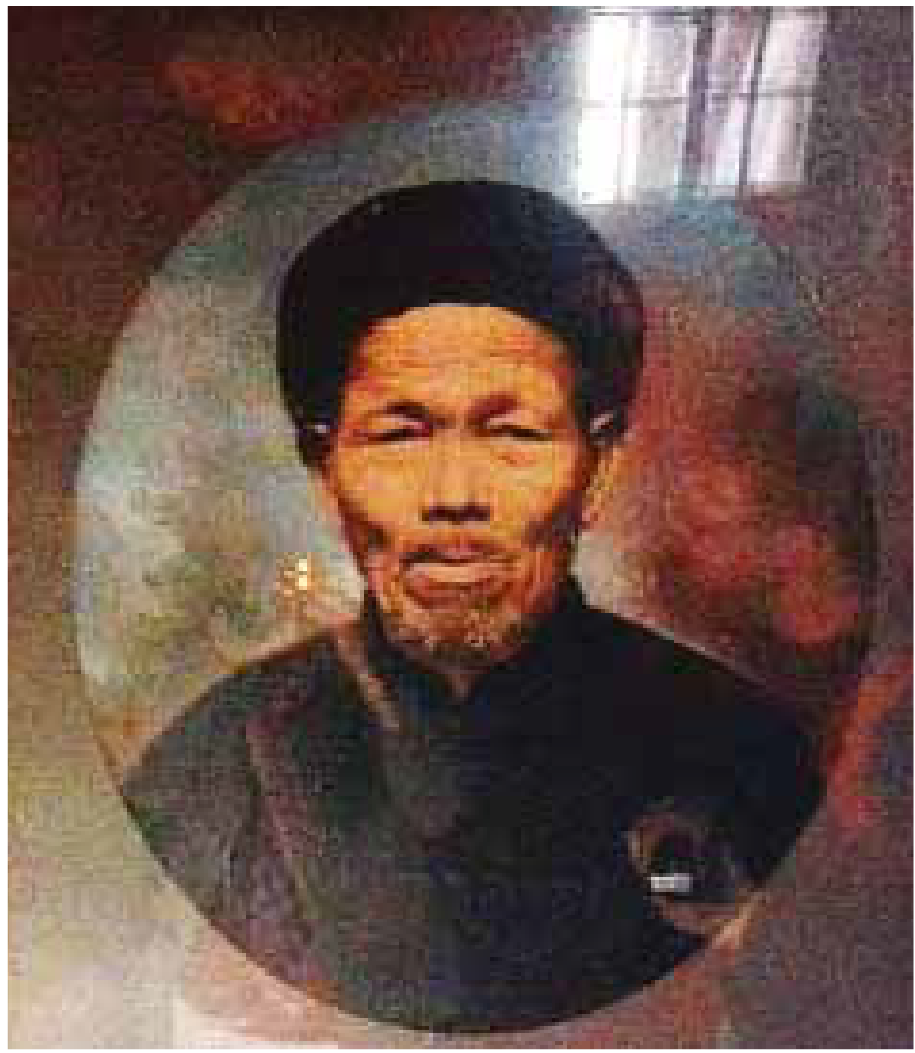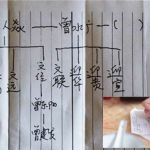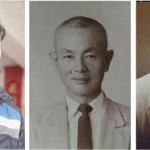Ed’s note: This is a continuation of Relative Finder’s “Saga after the storm.”

Aunty Marites finally arrived in Eni and met her long lost uncles. Upon her return she gave me colored photos from Chan Bon Kheng with notes at the back describing his return home to meet his long lost family in Iligan City, Lanao del Sur.
He had attempted to find his family in 1991 through Ed Lim’s family (his daughter is married to Ed’s mainland cousin). He eventually returned to China in 1998.
[Chan Tong Yang (left) narrates the names in Chan Bon Kheng family tree (right) while the author’s cousin Chan Na Na (曾娜娜) writes down (inset). This family tree is incomplete and the sequence of names does not necessarily follow the order of seniority. It shows the names of two of the four brothers who left Eni village to try their fortunes overseas in the Philippines. The name of Antonio Chan (曾人焱), center, appears on the top left. Beside his name is that of his younger brother Chan Chuy Kong (水廣) right.]
Reflections and recollections
I reflected on the early stages of our search, mostly done in Facebook, and recalled my earlier discussion with Chan Bon Kheng’s newly-found niece Evita through his cousin Enio. Enio had other Chan first cousins scattered in many places in the Philippines: Bulan, Sorsogon, others in Manila, even within my province, in a town called Pambujan.
After discovering I am from Northern Samar and my mother’s surname is Chan, Evita asked me if I am from the town of Pambujan. Back then, I dismissed it and continued to inquire other details of their immediate family’s history.
I recalled asking about the six pieces of old children’s solo photos sent by Chan Bon Kheng, and Evita said those are her father and aunts, although she didn’t recognize all the children. Her father said they were Elisa, Tirso (Bon Huan) and Estela – their cousins from Pambujan.
Even though the letters used brother in the salutations written at the back of the photos, the Chinese address same- generation male siblings or cousins as “brother.” It was only after meeting Chan Tong Yang that I realized that Elisa, Tirso and Estela actually meant “sibling” when they addressed Bon Kheng as “brother” many decades ago.
Close to home
My sister and a cousin married residents of Pambujan. I asked my mother-in-law, Muriel Lobos-Ty, and her siblings if they knew any Chan family. I especially sought her brother, Gilberto “Boy” Lobos, as he is my father’s mahjong mate and he was then a member of the town council.
I also asked my brother-in-law, Leny Balanquit, and his 70-year-old parents and discovered that the town adjacent to Pambujan, San Roque, is a new town and was historically once a part of Pambujan under the old name Laoangan. So, I asked high school classmates from there as well.
Yet, not one of them knew of a Chan in Pambujan. The Lobos and Balanquit families are two of the oldest families and Pambujan is a relatively small town where almost everyone is related to some degree.
Then, I remembered the recent photographs Aunty Marites showed me of Bon Kheng’s return to the Philippines, particu- larly of his sister, Elisa, in Mindanao. I realized Elisa, Tirso and Estela are not his cousins but his immediate siblings. So, Elisa is in Iligan, not in Pambujan. That would explain why no one knew a Chan in Pambujan.
Stitching the puzzle
I sorted through my cluttered China trip things after our honeymoon (my wife Sierra Ty and I were married in 2015). On the family tree was the name of Chan Bon Kheng’s father, Chan Din Yam (曾人焱). I recalled Evita has relatives in Pambujan and I felt strongly that these relatives and those of Bon Kheng’s are the same.
I went back to Kaisa’s Chinben See Memorial Library and scoured through the 1953 Philippine-Chinese Business Guide and Pictorial Directory by Diego Ingco. The town Pambujan isn’t there, as small towns usually don’t get listed in these kinds of national business directories. So I tried the year books of the Federation of Filipino-Chinese Chamber of Commerce and Industries Inc. from 1950s to 1970s. Luckily, there were indeed entries from Pambujan. There was a store proprietor named Antonio Chan and his Chinese name was Chan Din Yam! Antonio is Bon Kheng’s father.

Something else was nagging at me – this English name sounded very familiar. I suddenly recalled that this is the same name inscribed on the tomb my mother saw almost two decades ago when she attended a friend’s relative’s funeral in a nearby town. My mother had passed by a very curious-looking marker in the middle of the public cemetery. The tomb was marked with Chinese characters, but what made it interesting was the deceased’s name – Chan (曾) – the same as her maiden name. That was Bon Kheng’s father inside the grave my mother got so very curious about!
Here at last is factual evidence of that family’s existence.
Back to Pambujan

I recalled a lady who came to my parent’s house in Catarman back in Sept. 25, 2014, claiming to be a daughter of The author with Santos Chan. a certain Orling Chan, whom my mother knew from her childhood. Orling passed away in Manila and she asked for financial assistance to help transport her father’s remains from Manila to Northern Samar.
My mom and aunts recall Orling and his Chinese father, Pana Chan, lived near our ancestral house in Catarman. They even remember Pana selling dried squid in one of the stalls on the first floor of our ancestral house.
The lady’s grandmother was surnamed Atencio, and they lived in Pambujan before moving to Catarman. Unfortunately, mom forgot to get her contact number.
Seeking Santos
A breakthrough came during a family gathering. Someone mentioned a Santos Chan who lives behind the old church of Pambujan.
All Souls’ Day of 2014 offered an opportunity. My father- in-law was buried in the Pambujan public cemetery. During our grave visit, I searched the surrounding grave markers with Chinese characters but did not find it. I went back to Uncle Boy about Santos Chan. He finally consented to help.
It was a very short drive to the Pambujan church. The locals pointed to one of the nipa huts beside the church. We asked a child about Santos, and he called his grandfather, an elderly bald man in his 70s. Uncle Boy laughed upon seeing him – he is acquainted with Santos!
Santos is the brother of Orling and also a son of Pana. His mother, a local of Pambujan, is surnamed Atencio.
Santos is not the immediate family of Antonio Chan, but his mother’s cousin Pelagia married Antonio Chan. Santos’ father Pana is Antonio’s first cousin.
Santos said he is the last Chan in Pambujan. Antonio`s children have all left. I showed him pictures from the Facebook album of Ed Lim. He recognized all three children: Tirso, Estela and Elisa. He mentioned another brother named Osing, who went to Cabuyao, Laguna and that he owned a talyer (machine shop). Elisa married a man surnamed Tan who was a district engineer in Surigao.

Ed posted a Facebook message requesting help to find Elisa Chan. He also sent a private message to Rosemary Jane Sy Chua (蔡影蓮), a friend from FCCYA Iligan.
When Jane saw Elisa’s photo she immediately messaged her friend Suzanne Chan, who asked her parents for confirmation if Elisa is their relative.
Through Suzanne’s mother we finally received a name. Elisa’s husband is Engr. Calix Tan (陳海濱).
Ed and I searched for Calix Tan in the social media and the internet. Ed found a Facebook profile of an old man and his wife. The resemblance of the wife’s face to Elisa’s old child- hood picture was uncanny. Su- zanne also told Jane that the Tans have a store in Iligan. While waiting, we tried many other ways of reaching Calix Tan, none of which yielded positive results.
Path 2
Jane also asked other FCCYA members in Iligan, and a John Samson responded that he knew the name. Finally, on Feb. 18, we got confirmation that the name of Calix’s wife is Elisa Chan.
Jane texted Ed that Elisa had already been found but she is still looking for a way to communicate with them, as it’s not easy to talk to strangers in a Tsinoy community wary of kidnapping.
Fortunately, Ed discovered in Facebook a mutual friend, Aileen Te, from the FCCYA Tagbilaran, Bohol chapter.
Ed requested her to send the photo of Elisa to Calix Tan and tell him about the search for Elisa Chan.
The Tan family confirmed that the photo is that of Elisa Chan. After less than a week from starting the search, we have finally succeeded. Calix sent Ed a message thanking him for searching for them and that his wife was very happy:
“Happy Chinese New Year! I am Engr. Calix Tan of Iligan City. My wife is Elisa Chan Atencio. Her brother is Chan Bon Kheng… We have tried to contact him but two of his phone numbers does not answer. Even our cousin who went to Xiamen cannot contact him. We are very happy that you have information about him. I cannot convince him to stay with us here during his visit with the late Chan Bon Huan (aka. Tirso, Sonny).”

Opportune meeting
At the end of September, Ed went to Cagayan de Oro for a wedding. Jane agreed to accompany him to visit Calix and Elisa since she knew the address.
The next day, they went to the Tan store. One of their sons told them Calix and Elisa were at home. There, they met another son, Benjamin, who invited them to lunch.
After lunch, Benjamin and Elisa toured Ed and Jane around the city. Calix and Elisa were so happy to meet Ed and learn about the Bon Kheng saga. Ed explained that his cousin in China married Bon Kheng’s daughter. So Elisa and Ed were related, not by blood but by affinity.
On Osing and Estela
Back to Bon Kheng’s cousins from Pagsanghan. On Jan. 20, 2016, one of their China relatives informed me they were bringing his grandfather back to Samar to see his lost siblings in Pagsanghan.
Unfortunately, Elisa’s poor health prevented her from traveling to Manila. Instead, she gave me telephone numbers of her relatives in Manila; one was of her deceased sister Estela’s daughter. Another was Osing’s. It’s amazing to see the expanse of the bonds of friendships that were built between members from all over the country from networks as FCCYA.


